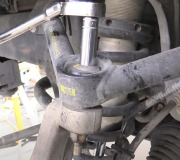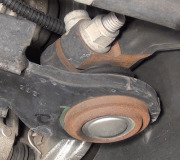Hi guys. You are over-thinking this. During the alignment, three things are going to be adjusted on each front wheel. The first two involve jockeying the two upper control arm mounting bolts back and forth until both camber and caster are correct. These adjustments interact, meaning moving one bolt changes both camber and caster. It is not as simple as setting one, and then setting the other one. You have to move both bolts around until both angles are correct, then you have to do the same thing on the other wheel, and both camber and caster have to be nearly equal to that on the first wheel. This can be a real lot of work and frustration, but specialists with a lot of experience know just how much to tweak each adjustment to make quick work of the job.
Once caster and camber are set on both wheels, the last adjustment is "toe", which is the direction that wheel is steering when the steering wheel is straight ahead. If the parts are not rusty, it just takes a minute or two on each wheel for these adjustments.
To add to my story about snapping a bolt, Chrysler has been famous for many years for using "cam bolts" for setting camber on their front-wheel-drive cars. You just loosen the nut, then turn the bolt to make the adjustment. However, on the Dodge Dynasty, they used the same setup GM uses. They have the same two bolts at the bottom of the strut, but no cam, or offset head. You simply loosen the bolts, shove the wheel to the desired setting, then tighten the bolts. The clamping force of the two bolts is all that holds the spindle in alignment, including when the tire hits bumps and pot holes.
A well-meaning coworker installed a pair of struts on a Dynasty, then handed the car off to me to align it. Both wheels were tipped in as far as possible, so first I had to jack up the car and pull them out. I tightened the bolts, set the car down on the hoist, and both wheels slid in again. I repeated this two or three more times and the same thing kept happening, then out of frustration, I hand-tightened the bolts as tight as I could get them, ... Until one snapped. That is when I took everything apart and found he had coated them with anti-seize compound. Those bolts are over 3/4" in diameter, and I snapped one with a hand ratchet thanks to that stuff. That is why I made the comment to not use anti-seize compound on the bolts. Once adjusted, you need the clamping force to hold them there and anti-seize compound prevents that.
Tuesday, July 24th, 2018 AT 8:01 PM




